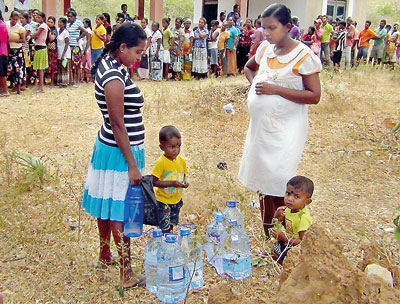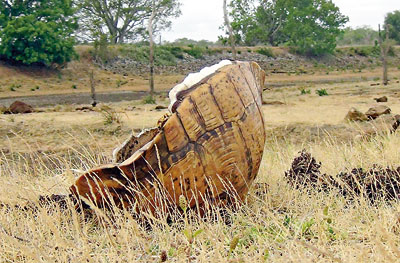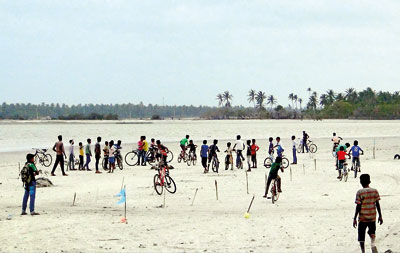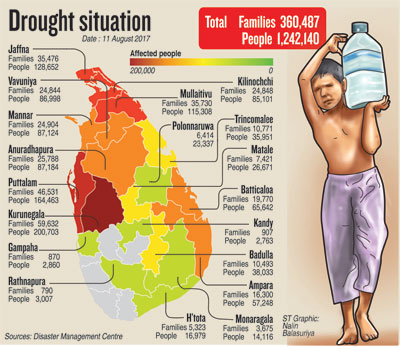News
Welcome rain brings some relief, but not enough to end drought
View(s):While torrential rains this week brought much needed relief to several drought-hit regions, officials warned that the drought itself is set to continue at least until the beginning of October.

Nuwara Wewa, Anuradhapura
Anuradhapura, Polonnaruwa, Trincomalee and Mullaitivu districts all received heavy rainfall over three days this week, resulting in significant improvement in some areas affected by drought. The most striking example was in the Trincomalee district. The Disaster Management Center’s (DMC) statistics issued a week ago on August 5 noted that nearly 141, 000 persons from more than 37, 000 families in the district were affected by the drought. This number has fallen to 36, 000 people from 10, 700 families as of yesterday (August 12). “The rains have significantly improved the situation in the Trincomalee district,” DMC’s Assistant Director Pradeep Kodippili, the told the Sunday Times. Mr Kodippili however, warned that there were still no signs that the drought was abating.
The rains “aren’t enough” and besides Trincomalee, the situation in most other areas remained the same, the official stressed.
The main problem continues to be a severe shortage of drinking water. Mr Kodippili explained the DMC has been distributing drinking water to drought-affected areas for the past eight months using about 500 bowsers, 200 of which were sent into service within the past two months as the drought became more intense. About 6000 water tanks have also been delivered to affected areas.
More than 1.24 million people from over 360, 000 families in 19 districts were affected by the drought as of yesterday, according to the DMC. Kurunegala district remained the worst with 200, 000 being affected, up from 151, 000 a week ago. This meant almost 60, 000 families. Puttalam district with over 164, 000 affected people was next. Jaffna District saw 128, 652 persons affected while the number in Mulliativu stood at 115, 308. Between 85, 000 to 90, 000 persons were affected in each of the districts of Anuradhapura, Vavuniya, Kilinochchi and Mannar.

Mahakumbukkadawala: Waiting for potable water
Meteorology Department Director K.H.M.S Premalal observed that water was still scarce in most drought-hit areas despite the rains this week. “We have to remember that many tanks in the affected areas have either run dry or their water levels have dropped considerably,” he pointed out. There has to be a prolonged period of heavy rain for the effects of the drought to diminish, and such rains are only expected towards the end of September when the inter-monsoonal rains become active, he added.
Inter-monsoonal rains generally account for 30 per cent of the country’s total rainfall and their effectiveness will be vital in ending the drought period, Mr Premalal noted.
The Irrigation Department has 73 major tanks coming under its purview. The total balance water availability of these tanks has now fallen to just 14 per cent, Wasantha Bandara Palugaswewa, Director of Irrigation (Water Management & Training) disclosed. “Many smaller tanks have run completely dry.”
Nevertheless, the Department had been able to release water adequate to cultivate about 50 per cent of paddy lands due to be cultivated during the ‘Yala’ season, Mr Palugaswewa claimed. “Despite the difficulties, we were able to release water for cultivation purposes and we are now at the tail end of the Yala season.” Water was still being released from certain large tanks in the Anuradhapura and Polonnaruwa districts.
Mr. Palugaswewa added that heavy rains which were experienced in Anuradhapura and Polonnaruwa this week was an encouraging sign and said officials were hoping for more of the same.
The drought has also impacted hydropower generation. However, some heavy rains were also experienced this week in areas where hydropower reservoirs are located. Maussakale, Castlereigh, Kotmale, Norton Bridge, Canyon, Lakshapana and Kukuleganga hydropower reservoirs received rains this week. This has resulted in total water levels of hydropower reservoirs reaching 39.6 per cent by yesterday, up from about 36.4 per cent two weeks ago, Director (Development) of the Ministry of Power and Renewable Energy and Ceylon Electricity Board (CEB) Spokesman Sulakshana Jayawardena stated. This however, is only a minor increase, he insisted.
At present, just 20 per cent of the country’s daily electricity demand is being met by hydropower. The balance 80 per cent is being generated mainly by diesel and coal power.

Thabbowa: Dead tortoise

Meegaswewa: Providing drinking water for hard-hit wild animals

Dried up tank in Kalpitiya. Pix by Athula Bandara, Hiran Priyankara Jayasinghe and Karuwalagaswewa Jayaratna


